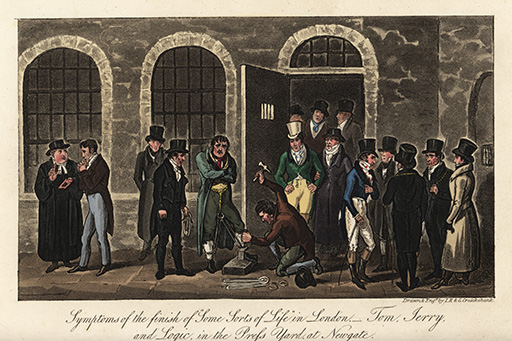3.1 The ‘Bloody Code’
During the eighteenth century, state violence against the person was accepted and this included capital punishment (execution) for those convicted of certain crimes. Across the early eighteenth century more than 200 acts were passed to make up to 200 separate crimes punishable by the death sentence. The majority of these were property crimes that you might consider to be fairly petty, including shoplifting or stealing a rabbit. This system of law was popularly known as the ‘Bloody Code’ and meant that people who were found guilty of crimes like highway robbery or theft could be hanged the same as murderers. Historians have for some time debated the significance and use of the ‘Bloody Code’ and what it tells us about the society that used it.
The gallows and hanging in popular culture
The Bloody Code was supposed to act as a terrifying deterrent to those who would commit crime and there is no doubt that the idea of capital punishment and hangings loomed large in the public imagination in this period. There are many illustrations featuring penitent prisoners awaiting their execution day like this one in Figure 18 which shows dandies (very fashionable young men) visiting a condemned man:

You can also find accounts of the lives and crimes of the condemned in newspapers and pamphlets, and sometimes the convicts themselves created their own narratives through confessions or final speeches.

Many historic images of hangings present them as public spectacles. A fair-day-like atmosphere accompanied hangings in London for much of the eighteenth century. Prisoners convicted at the Old Bailey Courts were taken from the cells of Newgate Prison and walked in procession along what is now Oxford Street to Tyburn, an area near today’s Marble Arch, where up to 20 convicts might be hanged at once. There were only eight of these occasions a year and they were often considered to be a public holiday with ale houses packed and street vendors selling foods (including gingerbread people supposedly in the shape of the prisoners) and copies of the final speeches of the condemned.
The imagery of Tyburn is widespread in cultural products and we can find it featured in print media, paintings, ballads and novels often created with a moral purpose. But how common was the death sentence under the Bloody Code?
Activity 8
Go to the Old Bailey Online website [Tip: hold Ctrl and click a link to open it in a new tab. (Hide tip)] . Open the link in a new tab or window so you can easily navigate your way back to the course.
Here you will find the records of London’s central criminal court. You are going to examine handkerchief theft prosecutions for one year.
Go to the Search Home page and use ‘handkerchief’ as your keyword, choose ‘Theft> all subcategories’ as the offence and leave all the other fields blank except for the dates. In dates choose January 1770 to January 1771 and search.
Here you can see all the cases prosecuted in twelve months that included handkerchief theft. Read as many cases as you like and make very quick notes about values of property, verdicts and sentences.
Discussion
You will notice that those found guilty were not automatically sentenced to death and hanged. There was a wide range of ‘secondary’ punishments (punishments used as an alternative to death) including transportation which was a common way of dealing with troublesome London youths, such as pickpockets. The perceived value of the item stolen mattered and so did the level of violence involved. Younger offenders and those committing property crimes, such as theft, that did not result in bodily harm or threats, were rarely sentenced to death despite the letter of the law. You may also have noticed how fascinating court records are in giving us a glimpse into everyday city life!
